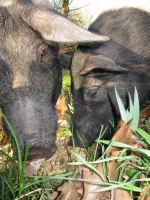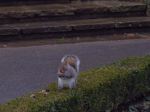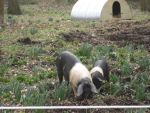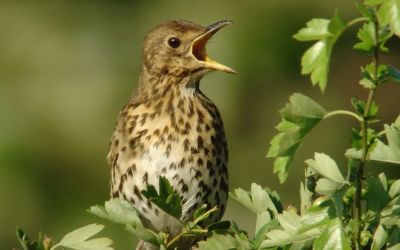|
|
||||||
| Stop Press - Winners | We have just heard that in the 2010 London in Bloom competition Holland Park has been awarded Gold. Westfield, Cremorne, St. Luke's and Little Wormwood Scrubs gained Silver Gilts. The Royal Borough won Gold in the City category and was outright winner in Group A. RBK&C also took first place in the floral display category. Our congratulations to all concerned. [Autumn 2010]
|
||||||
| And there in a wood a Piggy-wig stood... |  The park is using pigs to sustainably manage the Arboretum Enclosure and to re-establish the wildflower meadow, which has become encroached with bramble and nettles, and is in need of urgent attention if it is to be restored. The park is using pigs to sustainably manage the Arboretum Enclosure and to re-establish the wildflower meadow, which has become encroached with bramble and nettles, and is in need of urgent attention if it is to be restored.
The two options for restoring the meadow were spraying with chemicals or using pigs. Glyphosate, the only suitable chemical, is harmful to most plants and would adversely affect the park's biodiversity. Using pigs is the most sustainable approach with a minimal impact on biodiversity.
 They will turn over the bulbs in the area which is likely to reduce this year's flowers. However, they do not eat them, unlike our friend the squirrel who loves to eat bulbs! In the longer term the bulbs will benefit from the disturbance and being "chipped" will mean that they are likely to flower more vigorously in following seasons. They will turn over the bulbs in the area which is likely to reduce this year's flowers. However, they do not eat them, unlike our friend the squirrel who loves to eat bulbs! In the longer term the bulbs will benefit from the disturbance and being "chipped" will mean that they are likely to flower more vigorously in following seasons.These pigs, a sow and her three piglets, are British Saddlebacks. The breed was recognised in 1967 when the Wessex Saddleback and the Essex breeds were amalgamated. Both breeds date back to 1918. They are hardy and noted for their mothering capability. Pigs are effective foragers - using their highly sensitive snouts to turn the ground over so they can find a wide variety of foods such as roots, mushrooms, grasses, and earthworms.
 The pigs provide an excellent natural clearing source and can be used to remove bracken, bramble and nettles. This clearance of the 'brash' and undergrowth of woodland helps the regeneration of saplings, woodland pasture and small herbaceous plants. It is anticipated that the clearance may take up to three months, then the pigs will be removed, possibly to another area of the park. Once the pigs have turned over the soil, the emerging vegetation will be assessed as seed stock held in the soil has the opportunity to grow. If necessary, the enclosure will be reseeded with a woodland meadow grass and wildflower seed mix. The pigs provide an excellent natural clearing source and can be used to remove bracken, bramble and nettles. This clearance of the 'brash' and undergrowth of woodland helps the regeneration of saplings, woodland pasture and small herbaceous plants. It is anticipated that the clearance may take up to three months, then the pigs will be removed, possibly to another area of the park. Once the pigs have turned over the soil, the emerging vegetation will be assessed as seed stock held in the soil has the opportunity to grow. If necessary, the enclosure will be reseeded with a woodland meadow grass and wildflower seed mix.Wildflower meadows are a valued part of our countryside and are one of our fastest disappearing habitats: over 95% have been lost. As a result, many of our native wildflowers are in decline and some have almost disappeared. Wildflower meadows support birds and small mammals; they are also home to many invertebrates, including butterflies, grasshoppers and bees.[Spring 2010]
|
||||||
| Woodcock in Holland Park |
No, this isn't an article about one of the famous pre-war shooting parties the Ilchesters used to hold in the Park. During his breeding bird survey of Holland Park in 2009 David Darrell-Lambert saw two woodcock fly up from the northern end of the sports field early in the morning of 29 March, and during the evening of 16 April he heard a bird calling from the northern woodland. Great stuff! Unlikely I'm afraid that we can count woodcock as one of our regular breeders, but please keep a look out this spring. The survey, which took place between February and May and was the first to be carried out in the Royal Borough since 2006, produced some fascinating findings. No less than twenty-eight species of bird were regarded by the survey as breeding in the Park. They included our regular "garden birds": great, blue and coal tit, long-tailed tit, wren, robin, blackbird, song and mistle thrush, dunnock (hedge sparrow), chaffinch and greenfinch, great spotted woodpecker and starling. Other regulars were the little goldcrest (our smallest bird), wood pigeon, crow, magpie and jay. Mallard were included but not moorhen (please see the article in last Autumn's newsletter) simply because there was no evidence of breeding at the time of the survey. By no means regular in the past, but also on the list, were goldfinch, rose-ringed parakeet (see Joy Puritz's article in this issue of the newsletter), stock dove, tawny owl and – quite a surprise – green woodpecker and nuthatch. In the case of these last two however, a word of caution: green woodpeckers regularly visit the Park but are not by any means present every day and can hardly be classified as "resident". Their song was heard during the survey but they might have nested outside the Park. The nuthatch (small, with a blue back and yellowish breast, longish beak, rather like a mini-woodpecker and something of a coup for the Park) has been seen quite often over the past two years, mostly on the cage feeder in the Dutch Garden. Its song was last heard during the survey on 1 May, then there was a gap until its reappearance in the Park in September, so it is doubtful it bred here.
Our regular spring migrants, the blackcap and chiffchaff, also figure on the list – up to six pairs of blackcap but only one of chiffchaff.
A winter footnote: the harsh weather has brought some compensations for the enthusiastic birder in the Park. As well as the usual variety of black-headed, common and herring gulls there have been several sightings of redwings, the pretty winter thrush from Scandinavia. On 15 January I counted over fifty on the sports field. They have been joined by a few of their larger and handsome, colourful cousins, the fieldfare, on two or three occasions – indeed on 14 January we had all the thrushes present on the sports field together: blackbird, song thrush, mistle thrush, redwing, fieldfare. Excellent!
David Jeffreys
David Darrell-Lambert's website address is www.birdbrainuk.com
[Spring 2010] |
||||||
| A pest, or what? |
In Holland Park nowadays, and at any time of year, a distinctive bird sound (I hesitate to call it "birdsong") is the squawking call of the ring-necked parakeet, also known as the rose-ringed parakeet or, in Latin, Psittacula krameri. I first heard and saw this bird when on a guided pilgrimage to Canterbury at the end of December 1999, south east of Blackheath on the Kent borders. I was told then that these exotic birds, kept as pets since Victorian times, had escaped or been released from captivity over many decades and were establishing themselves in the south east (some escaped during filming of The African Queen in Shepperton Studios in 1951, and from aviaries damaged by the 1987 hurricane). According to the British Trust for Ornithology the bird began breeding annually in the UK in 1969, the two largest populations being in the southern part of Greater London and in the Isle of Thanet, Kent. The population in Thanet has been increasing by 15% per year, in Greater London by 30%, and the range in the latter area has been expanding by 0.4 km per year. The first sighting in Holland Park is thought to have been in 2006. In 2007 five were spotted, and now David Darrell-Lambert, who conducted the 2009 bird survey for our borough, believes that three pairs are breeding here. Rhoddy Wood, our secretary, saw a pair of great spotted woodpeckers becoming very aggressive toward parakeets approaching their nest hole but, sadly, woodpeckers have been driven out in at least one area of west London.
Although they are naturally vegetarian – eating fruit, berries, nuts, seeds and grain – these birds will eat any kinds of scraps available in urban and suburban environments, which is why they seem so happy in any of Greater London's thirty-three boroughs where they will also raid, and often damage, bird feeders. The spring-loaded feeder in the Dutch Garden in Holland Park has perches which, when stood on by heavier birds, bring down a shutter covering the feed holes. This has mostly defeated the pigeons, but the parakeets have such prehensile claws that they are able to hang on to the feed holes themselves instead of standing on the spring-loaded perches. Fortunately they have not damaged the feeder, nor can they get much from the caged feeder next to it, but ideally completely parakeet-proof feeders are needed. Some believe that these birds would not survive English winters without the food in gardens, and being rather sedentary in their habits they are likely to stay here, and any seen elsewhere in the country – and there have been sightings in almost every county, in Wales and the Scottish borders – are most likely to be local escapees. There are three other species of parakeet breeding in the wild in Britain: the monk parakeet, the alexandrine parakeet and the blue-crowned parakeet.
The Indian ring-necked parakeet is a mid-sized, long-tailed pale green bird with a red, parrot-type beak. Beneath its bill the male has a small black bib which extends back across the neck in a thin black line bordered by pink or orange. Its original habitat is the Himalayas but it is now widespread from Asia across the Middle East to West Africa. Coming from the mountains it has had no trouble adapting to British winter temperatures. It is a hole-nester and often starts nesting in the UK as early as January, giving it the opportunity to take over nest boxes or woodpecker, owl and nuthatch nest holes before the competition starts. Nesting success is very high. The 2-4 eggs are incubated for three weeks and the fledglings cared for by both parents; the young fledge at 40-50 days old and normally mature to breed at three years. These birds have few predators and outcompete local birds for food. They now number about 44,000 in Britain and their spread needs to be monitored. Defra (Department for Environment, Food and Rural Affairs) is funding research to assess potential negative impacts on our native bird species. There is also growing evidence of damage to crops, orchard fruits and vines.
On 3 October 2009 Natural England made a statement that although the licensing situation for culling would change from 1 January 2010, neither monk nor ring-necked parakeets would then be considered as pests (pests may be "freely removed" by members of the public), nor was Natural England calling for the eradication of these species. It is still illegal to kill or interfere with these birds except in exceptional circumstances, and in such cases a licence would be needed. From 1 January there was a change in the way people can apply for culling licences: previously they had to apply individually, but now, through a general licence, permission is automatically available to, for instance, farmers whose crops are being damaged, or where a habitat needs to be conserved, but only when scaring or exclusion tactics have proved ineffective. Except for such proven cases of damage, therefore, these species are still protected under the Wildlife and Countryside Act (but it is illegal to release a parakeet or allow one to escape). Potential control methods include trapping or shooting. Defra is funding research on the feasibility of chemical sterilants for controlling parakeet populations which might prove necessary in the future.
More alien species live in Britain than in any other European country, mainly due to the movement of people and goods in trade: think of all those Commonwealth countries with which we connect. The jury is still out on the subject of parakeets, but many fear that they pose a serious threat to our smaller birds. Some will point out that we have been introducing non-native species for hundreds of years: take potatoes, dahlias and cats, for instance. Are we being eco-xenophobic to consider the ring-necked parakeet as the grey squirrel with wings?
Joy Puritz Joy Puritz
[Spring 2010]
|
Horticulture and Wildlife in Holland Park 2010

 So, which do you think are the most frequent birds in the park? On 28 October David Darrell-Lambert, who two years ago carried out a survey of the birds breeding in Holland Park, was our guest speaker for the Friends' autumn event in the Orangery. He was able to tell us that there were at least 28 species with up to 304 breeding pairs. For breeding to take place you need, of course, a pair of birds, good quality woodland, shrubs, bushes and hedges, good food sources and nesting places. Trees act like magnets to birds which will head for the green, using people's gardens as corridors on the way to the parks.
So, which do you think are the most frequent birds in the park? On 28 October David Darrell-Lambert, who two years ago carried out a survey of the birds breeding in Holland Park, was our guest speaker for the Friends' autumn event in the Orangery. He was able to tell us that there were at least 28 species with up to 304 breeding pairs. For breeding to take place you need, of course, a pair of birds, good quality woodland, shrubs, bushes and hedges, good food sources and nesting places. Trees act like magnets to birds which will head for the green, using people's gardens as corridors on the way to the parks.